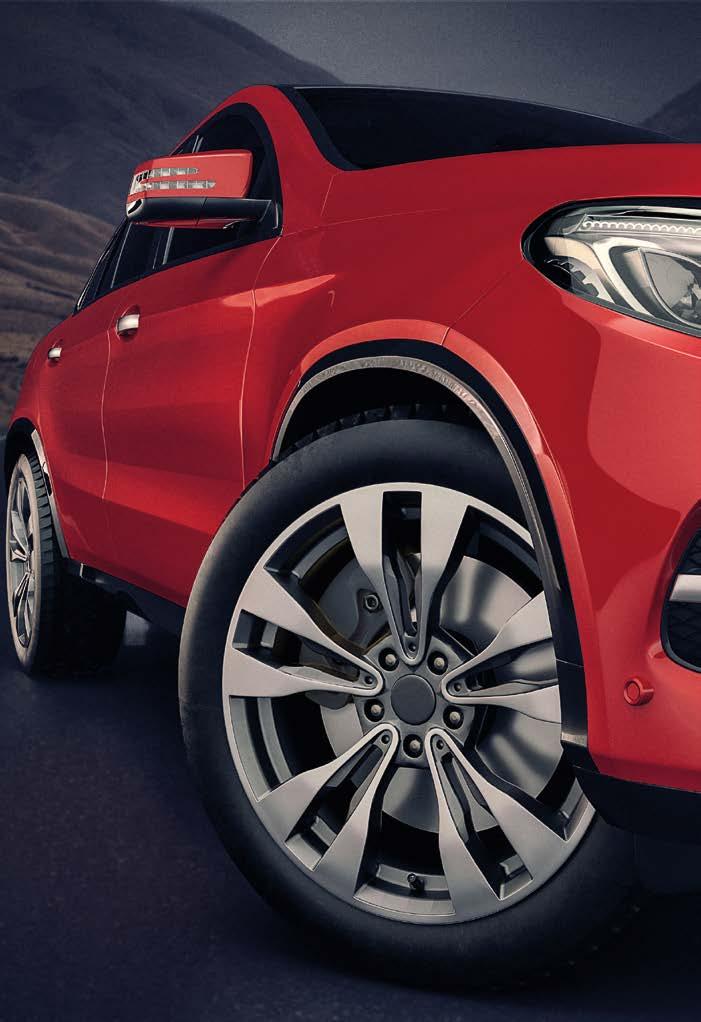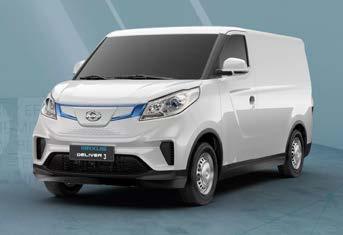
10 minute read
SBT Motoring
from SBT issue 445
SBT
MOTORING NEWS
SBT MOTORING NEWS SPONSORED BY:
ELECTRIC COMMERCIAL VEHICLES
OUT NOW AND COMING
WHAT IS CAZ?
BROUGHT TO YOU BY RIVERVALE LEASING
Electric commercial vehicles
out now and coming
Electric commercial vehicles are coming onto the market by the bucketload. There is, of course, more and more demand for electric vans, as more businesses, both small and large, feel the impetus to drive towards a Greener future.


Both for private and Motoring News commercial vehicles, there is a constantly growing demand for electric vehicles - ones that are better than their previous incarnation, are cheaper or are kitted out with everything you expect from an ICE drive (and more). When they deliver just as an ICE engine does, but without the costly carbon footprint, it’s a nobrainer to go green. Large city centres often impose clean air zones, so the business imperative to drive more cleanly in these areas can be a costly error to fall foul of. Due to pressure from the consumer, business incentives and punitive measures on carbon-emitting vehicles, green commercial vehicles are doubtless here to stay - and well worth early investment. This is our list of our favourite electric commercial vehicles 2021.
Best small electric vans
There’s been movement in the small electric van market as more smaller start-ups and self-employed workers combine business with everyday driving.
Renault Zoe Best for small car usability and impressive range
Speaking of small vans to combine work and daily driving, the Renault Zoe van is a real exemplar of this trend. Basically, a compact car with the passenger seats removed, the Zoe van is excellent to drive, quiet, and comfortable. It’s small 387kg payload, and 0.5m3 of capacity won’t fit all commercial needs, but the range will certainly keep many happy - an 80kW motor plus 52kWh battery make for a 245-mile range. For smaller carrying capacities who need a comfortable city car that can adapt to daily life and longer journeys, this is a winning option.
Read more: April 2021 Changes to Electric Company Car Tax
Nissan eNV200 Best for carrying capacity at micro size
At the other end of the small van, spec is the Nissan eNV200. It offers a sizable load volume but in a small van category, great for urban deliveries. With a real-world driving range of just over 100 miles (174 official range), it can’t compete with more car-like models such as the Zoe, but it allows for maximum carrying capacity in a small, zero-emission van.
Renault Kangoo ZE Europe’s best-selling small electric van
The latest Kangoo ZE offers a massive 70 miles more range than the previous electric Kangoo due to a new 59bhp electric motor (a variation of the one used in the Renault Zoe). With a realworld driving range of 120 miles, the Kangoo combines a car-style drive with


great small van capacity. It comes as a standard-length van, the ZE Maxi (longwheelbase version) and the ZE crew variant, which can carry up to five.
Best medium electric vans
Medium electric vans are set to explode in terms of choice, as exemplified by the imminent arrival of Ford’s electric variant of the everpopular Transit. The PSA Group leads the way in this sector currently, with its Citroen, Peugeot and Vauxhall brands.
Read more: Green Number Plates Introduced on UK Roads
Maxus E Deliver 3 An engaging, zippy drive
The Maxus E Deliver 3 offers two sizes - the standard and the longwheelbase - but it’s really the latter of these choices that offers the best ‘medium van’ spec. The standard comes in at a 4.8m3 capacity, whilst the larger wheelbase affords 6.3m3 of loadspace (with maximum payloads of 905kg and 1020kg, respectively). Capable of 150 miles, this is a ‘get the job done’ electric van to fit the bill.
Mercedes Benz E-Vito The clever, innovative electric van
The Mercedes E-Vito is class-leading in medium-sized vans in terms of tech. Its set of regenerative braking levels almost emulate a gearbox, allowing you to slow or coast. Its 85kW motor makes for a zippy drive and offers a 93-mile range. With a payload of 1015kg and a capacity of 6m3, it delivers practically as well as aesthetically - Mercedes always comes up trumps when it comes to good-looks and reputation. It does not support quick charging (it only supports up to 7kW), so this may be a consideration if you’re looking to undertake longer distances and charge publicly rather than overnight at home/ on business premises.
Best large electric vans
The large electric vans market is quite new, but there’s already hot competition. Batteries can eat into payloads, which is a challenge in the large van category, as they are already quite heavy, nearing the 3.5-tonne maximum weight limit.
Renault Master ZE Renault’s large zero-emissions option
The Renault Master ZE fills in the blank in Renault’s EV van offering. Dominating the market in EV sales (claiming 25% of EV sales worldwide), Renault offers the Kangoo ZE as their small electric van, but this is their first large electric option. It uses much the same tech as the Kangoo and offers similar all-round appeal. The official driving range is 124 miles (with realworld range likely to be nearer 74), so it’s a great large van for city deliveries.
Read more: Top 5 Electric Vans for Eco-Conscious Businesses Mercedes Benz e-Sprinter
The Mercedes Benz e-Sprinter is a similar offering to the eVito, but is bigger. Some might even class it as a better offering, as it supports rapid charging - the lack of which might be a deal-breaker for some in the smaller eVito. It only offers one body size, but can transport up to 1045kg, in 11m3. The real-world range offered hits up to 96 miles. As ever, it comes with that quality level standard to Mercedes Benz, so although it represents a bigger investment, it can earn its keep relatively quickly and easily.
Eco-consciousness is only going to grow as the government works towards its Road to Zero plans for zero emissions by 2050. Some measures already penalise carbon emissions, and failing to move to a zero-emissions car or fleet may really hit your bottom line. If going Green is your plan for your next purchase of a commercial vehicle, take a look at Rivervale’s electric van leasing options, whether you’re in the market for a small, medium or large vehicle.
Give our friendly team a call on 01273 433480 to discuss your options, or request a callback and one of our team will be in touch.

What is a CAZ?

A Clean Air Zone (CAZ) is an area where special measures have been implemented to help improve air quality.
This governmentMotoring News backed initiative is designed to discourage people from driving older vehicles which produce more emissions.
There are two different types of CAZ:
Non-charging CAZ - Vehicles driving through these areas will not be required to pay a fee. But you will notice other measures to improve air quality like cycle lanes, better public transport services and modified road layouts.
Charging CAZ - Anyone driving a vehicle that doesn’t meet the minimum emission requirements for the CAZ will be required to pay a fee.
Why are CAZ’s being introduced?
In 2010, the UK committed to limiting air pollution, including harmful NO2 (nitrogen dioxide) emissions. The Government also pledged to create an Air Quality Plan whenever the limits were found to have been breached.
Read more: How to Get the Most Range From Your Electric Car
Unfortunately, those limits have been breached every year since they were introduced. As a result of this and subsequent legal challenges, the Government has produced a number of Air Quality Plans.
The 2017 publication highlighted 29 of the most polluted local authorities. The Government asked them to put together plans to reduce NO2 in their area. Following yet another legal challenge in 2018, 33 more local authorities were tasked with the same initiative.
CAZ’s were expected to be brought in during 2020, but the global pandemic has meant this has been pushed back by most local authorities.
Why are CAZ’s different between areas?
Local councillors are responsible for
setting the parameters for their CAZ. Provided that the plan sets out to reduce NO2 as fast as possible, it is down to the local authority to decide whether a CAZ is needed.
If a CAZ is deemed necessary, they will also have the power to set the boundaries and identify key policies. They will also decide whether it should be charging or non-charging. That said, a charging CAZ should only be used where non-charging measures will not improve air quality quickly enough.
As a result, different areas of the country will have different strategies for improving air quality. The pricing structure for charging CAZ’s will be different, too, with some areas charging more than others. In some places, the CAZ will be in place at all times, whereas others may only operate it within certain hours of the day. Being aware of the various conditions could be problematic if your fleet travels through several different areas.
Read more: Which Electric Car Is Right For Me?
Which vehicles will be affected by CAZ?
Local authorities will have the final say on which vehicles will be charged (if any) within their CAZ. But the Government has offered some guidance through its Air Quality Plan. This outlines the four classes of charging CAZ’s to identify which vehicles will be required to pay a fee for driving through them:
• Class A for buses, coaches, taxis and private hire vehicles • Class B for Class A + HGV’s • Class C for Class A + Class B + small vans, large vans, minibuses • Class D for Class A + Class B + Class
C + cars, motorcycles, mopeds
(Source: Department for Transport) Minimum emissions standards will apply within a charging CAZ, and these are based on the vehicles Euro emissions standard.
Are any CAZ’s already in operation?
Technically, London has been operating a type of CAZ for more than ten years, although it’s known as the Low Emission Zone (LEZ). Older vans and lorries have had to pay a fee to travel through the LEZ since 2008.
The Ultra-Low Emission Zone (ULEZ) in London requires vehicles not meeting the minimum emission standards to pay a fee. This has been in place since April 2019 and requires drivers of noncompliant vehicles to pay £12.50 per day. It covers the same parts of Central London as the Congestion Charge Zone. Larger vehicles like HGV’s, buses and coaches have to pay £100 per day if they don’t meet the minimum emission standards. introduced in Birmingham on 1 June 2021. It will apply all year round. The daily cost for cars and motorcycles will be £8 per day. For larger vehicles, this will be £100 per day. Minibuses transporting school children will be exempt.
Other major cities
Further modelling was carried out in Greater Manchester and Bristol to explore whether air quality changes after the pandemic were enough to prevent the need for a CAZ. In both cases, the improvements were not enough to retain cleaner air. This means there is an ongoing risk to public health. Over the next year, drivers will see CAZ’s being introduced in Greater Manchester and Bristol as well as many other major UK cities, including Bradford, Cambridge, Oxford and Sheffield.
Read more: Government Announces 2030 Ban on Petrol and Diesel
Read more: Top 7 Electric Vehicles Arriving in 2021
There are plans to extend the ULEZ to cover other London Boroughs during Autumn/Winter 2021.
Bath
A charging CAZ was introduced by Bath City Council on 15 March 2021. It applies 24 hours per day throughout the year.
HGV’s, buses and coaches which don’t meet the minimum emission standards have to pay £100 per day. Taxis, vans and minibuses have to pay £9 per day. Cars and motorcycles are exempt at the moment.
Which other areas plan to introduce a CAZ?
Birmingham
A 24-hour charging CAZ is set to be
What is the best way to manage non-compliant vehicles in my fleet?
ANPR cameras will be installed in CAZ zones to ensure compliance. With a penalty of £120 per day, businesses with more than one vehicle are encouraged to register for the charging checker before CAZ’s go live. The charging checker will allow you to register non-compliant vehicles. You will be able to make the necessary payments either seven days in advance of travel or six days in arrears.
If you’d like to learn more about low emission leasing or have any questions, give us a call on 01273 433480 or request a callback at a time that suits you.




